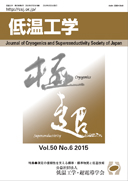All issues

Volume 50, Issue 6
Displaying 1-7 of 7 articles from this issue
- |<
- <
- 1
- >
- >|
Preface
-
Hiroyuki NOJIRI2015 Volume 50 Issue 6 Pages 287
Published: June 25, 2015
Released on J-STAGE: July 07, 2015
JOURNAL FREE ACCESSDownload PDF (632K)
TEION KOGAKU 50th Year Commemorative Articles Editor’s Choice
-
Takashi NOGUCHI2015 Volume 50 Issue 6 Pages 294-296
Published: June 25, 2015
Released on J-STAGE: July 07, 2015
JOURNAL FREE ACCESSDownload PDF (3186K)
Feature: Measurement Standards, Reference Materials and Cryogenics to Support Measurement Reliability
-
Takeshi SHIMAZAKI2015 Volume 50 Issue 6 Pages 297
Published: June 25, 2015
Released on J-STAGE: July 07, 2015
JOURNAL FREE ACCESSDownload PDF (452K)
Focused Reviews
-
Hisashi NAKAGAWA2015 Volume 50 Issue 6 Pages 298-305
Published: June 25, 2015
Released on J-STAGE: July 07, 2015
JOURNAL FREE ACCESSIn order to ensure the reliability of research results obtained in very low temperature fields, it is important that very low temperature measurement is traceable to the internationally agreed the Provisional Low Temperature Scale of 2000 (PLTS 2000). The PLTS-2000 is defined by the relationship of 3He melting pressure pm to temperature T2000 in the range of 0.9 mK to 1 K and provides four intrinsic fixed points on the melting curve. In order to realize the PLTS-2000, it is necessary to cool 3He at melting pressure down to the possible lowest temperature using a nuclear demagnetization cryostat. This cryostat must be capable of working reliably and continuously over long periods of time during ultra-low temperature experiments. In this article, we give information about low-temperature techniques for realizing the PLTS-2000 based on our experiences of designing and constructing in-house ultra-low temperature apparatus.View full abstractDownload PDF (1302K) -
Takeshi SHIMAZAKI2015 Volume 50 Issue 6 Pages 306-313
Published: June 25, 2015
Released on J-STAGE: July 07, 2015
JOURNAL FREE ACCESSAccurately calibrated thermometers are an indispensable tool for reliable and precise temperature measurements. The International Temperature Scale of 1990 (ITS-90) was adopted by the Comité International des Poids et Mesures, CIPM in 1989 to enable accurate and reliable temperature measurements around the world. We realized a temperature scale for the lowtemperature region in accordance with the ITS-90 and calibrated standard resistance thermometers. We also developed a resistance thermometer calibration apparatus based on a pulse tube / 3He JT cryocooler. The calibration apparatus is intended to operate between 24.5561 K (temperature of the triple point of Ne) and 0.65 K (lowest defied temperature of the ITS-90), and is used for comparison and calibration of standard resistance thermometers. The apparatus can reach 0.5 K in continuous operation mode. The temperature control stability at the thermometer comparison block of the apparatus over the operation temperature is better than 0.07 mK, expressed as standard deviation of the temperature variation measured for 15 min. The vibration at the comparison block was also measured and found to be approximately 0.01 m/s2 at maximum. This level of vibration does not affect the calibration of the standard resistance thermometer.View full abstractDownload PDF (2711K) -
Haruka ABE2015 Volume 50 Issue 6 Pages 314-321
Published: June 25, 2015
Released on J-STAGE: July 07, 2015
JOURNAL FREE ACCESSSpecific heat capacity is one of the most important thermodynamic properties for materials. In the National Metrology Institute of Japan (NMIJ), we have developed a new type of cryogenic adiabatic calorimeter applying a pulse-tube (PT) refrigerator for specific heat capacity standards. By using the PT refrigerator and a digital PID control system, the calorimeter realized easy and safety operation, full automation, and continuous long-term operation. In the first step, we measured the specific heat capacity of NIST SRM720,1) synthetic sapphire, in order to check the performance of the equipment and estimate the uncertainty of measurement. In the next step, we measured the specific heat capacity of a single-crystalline silicon. Certified reference material (CRM) for the specific heat capacity was produced in accordance with the quality system of NMIJ, which is in compliance with ISO Guide 34 and ISO/IEC 17025. In this paper, we discuss the development of a standard and CRM for specific heat capacity at low temperatures.View full abstractDownload PDF (1583K) -
Takeshi IKEGAMI, Ken-ichi WATABE2015 Volume 50 Issue 6 Pages 322-329
Published: June 25, 2015
Released on J-STAGE: July 07, 2015
JOURNAL FREE ACCESSThe principle and the current status of cryogenic sapphire oscillators are reviewed. Cryogenic sapphire oscillators have achieved a frequency stability of better than 10-15. They have been utilized for testing fundamental physical principles, as local oscillators for primary frequency standards and for radio astronomy. It is expected that they can possibly be used as local oscillators to keep time in the era of optical atomic clocks after redefining the second in future. The efforts attaining a frequency stability better than 10-16, which is the best stability of the microwave oscillator, are also described.View full abstractDownload PDF (2254K)
- |<
- <
- 1
- >
- >|